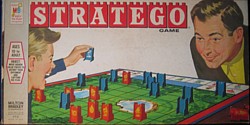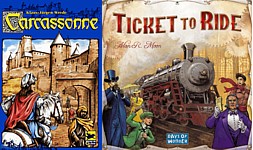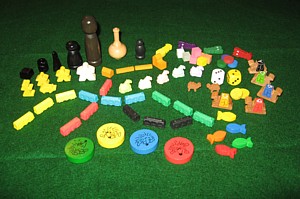What Games Did You Play Growing Up?
You like to play fun board games. I know because here you are! Welcome to FunBoardGames.org where you can learn about fun board games for all ages – kids, teenagers, college students, and adults – couples, families, and so on. There are many fun board games that you’ve likely never heard of before.
What is it that makes a board game fun? The answer varies depending upon whom you ask. Personally, I think almost any board game is fun. However, a fun board game for your kids might be boring for teenagers and adults. Board games that adults like to play can be too hard for young children to learn and understand – thus, no fun. There are many board games though that are fun for everyone.
Parents who have children still at home should seriously think about using fun board games as a way to interact as a family. Grandparents can do the same, if they live near enough or whenever they take a vacation to visit their grandchildren.
When You Were Younger

As an adult, you may remember playing fun board games as a child. Did you play Candy Land? Chutes and Ladders or Snakes and Ladders? Monopoly? Clue? Life? Sorry!? Scrabble? Risk? Anything else come to mind?
How about the venerable classics like checkers, chess, pachisi, Othello, or pente? Those are still considered to be fun board games. After all, that’s how they came to be classic board games.

Have you played board games with a theme about war like Axis & Allies, Stratego, or Combat? I’m not suggesting that war is a fun pastime, and that’s not what those games are trying to suggest either. Yet, if you enjoy the strategic challenge that comes with board games with this theme, they can be fun board games too.
Do you have a mind that remembers all sorts of trivia? You may have fun playing board games like Go to the Head of the Class or Trivial Pursuit and its many incarnations. (What is the largest city in Arizona anyway?)
A New Era in Fun Board Games

In 1995, a board game called The Settlers of Catan was published that has become the most widely played board game of a type commonly called Euro board games.
I didn’t discover this fun board game myself until (or rather, it was introduced to me by a friend in) 2006. That was the year I became hooked on Euro board games.
Euro board games (Eurogames, for short or Euros, for shorter) have many similar characteristics as far as components, rules, playing time, player interaction, and level of abstraction are concerned. It’s the fact that many of them were created in Germany though that allows them to be nicknamed Euros. You’ll often hear them referred to as German board games as well. The terms are interchangeable.

I first played two other fun board games (both Euro board games) in 2006, Carcassonne (published in 2000) and Ticket to Ride (published in 2004). Both are also fairly well-known for Euros – even though you may not have heard of them until just now. (But that’s okay; that’s part of the reason you’re here!) Along with The Settlers of Catan, these three board games are often labeled “Gateway Games”, since they are frequently used to introduce players to Euros who have never experienced them before.
The Euro Board Game
As I hinted at earlier, there are several aspects of these Euros that make them fun board games for an increasingly large number of people.
- They have attractive components.
- The rules are usually relatively simple to learn.
- Playing time is short (45-90 minutes) compared to some “heavier” games which can take several hours, if not days, to play.
- There is a fairly high level of player interaction.
- The level of abstraction is quite high compared to board games that rely heavily on a theme.

Take a look at some of the components used in a few of these fun board games. Painted wood is commonly found in abundance here, though plastic and other materials are not unheard of. The wood can be cut into all sorts of interesting, intricate shapes. These pieces, or bits, are simply fun to handle and play with.
Rule books generally aren’t anything close to book length. They are usually only a few pages long (unless printed in multiple languages, which thankfully is a rather common practice). Sometimes a single page suffices. But don’t let the brevity deceive you. You will still find plenty of interesting and fun gameplay in those few pages. Just a few simple rules can lead to the most fun board game you’ve ever played.
The first time you play a Euro board game, it may take significantly longer to play than you thought it would (or than you were told). This is simply because you’re new to it and are still learning the mechanics (that is, mechanisms) used to play – what you can do, where and when you can do it, etc. Your second and subsequent plays of the same board game are very likely to finish much more quickly. And, as stated, that will often be 45-90 minutes, though some great, fun board games will be much shorter and some will be longer than that average.
Euro Board Games = Fun Board Games
Most fun board games were meant to be played face-to-face with and against other people. Part of what makes Euros so much fun is that you are sometimes forced (by the rules) to interact with your fellow players. You might trade goods (bits of wood or cards) with them. You might force their dudes out of a region on the board where they had control (and were intending to score a boatload of points). You might head them off at the pass and prevent them from completing a goal (which probably would also have scored them lots of points).
Euro board games usually have some sort of theme associated with them – building cities, connecting cities with railways, growing crops and/or herding animals on a farm or plantation, playing the detective to solve the mystery, and so on. Sometimes this theme is really only secondary to what’s really going on in the game, which is moving bits around on the board, collecting some of them for yourself, and gaining points towards your goal of victory.
Some games could easily be played under any number of themes without changing any of the rules themselves. If that’s okay with you, Euros will be fun board games for you. Part of what makes a theme “stick” is how much effort the players put into making it stick. For example, if you only refer to the blue, octagonal, wooden cylinders as “blue thingies” (to distinguish them from the yellow ones), you won’t enjoy the theme much, and it won’t stick for you; it will feel “pasted on” instead. On the other hand, if you consistently call the blue ones “indigo” and the yellow ones “corn”, you’ll feel more like the plantation owner producing, selling, and shipping his crops. That’s what makes up a lot of the fun in these fun board games.
Finding Fun Euro Board Games
So where can you find these fun Euro board games? Not likely at Walmart or Target. One of the best places to shop is online, perhaps at eBay or Amazon. There are lots of fun games waiting for you. Try a new one today.
